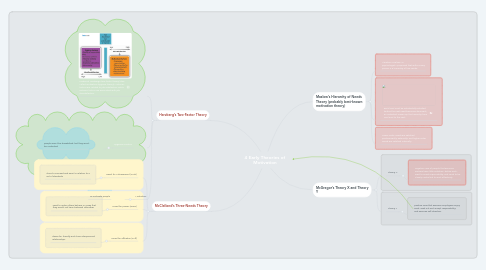4 Early Theories of Motivation
by A. RAHMAD BIN NGAH / UPM


1. Herzberg’s Two-Factor Theory
1.1. Frederick Herzberg’s two-factor theory (also called motivation-hygiene theory)—intrinsic factors are related to job satisfaction, while extrinsic factors are associated with job dissatisfaction.
1.2. Hygience Factors
1.2.1. people won’t be dissatisfied, but they won’t be motivated
1.3. Motivators
1.3.1. To motivate people
2. McClelland’s Three-Needs Theory
2.1. Need for Achievement (nAch)
2.1.1. drive to succeed and excel in relation to a set of standards
2.2. Need for power (nPow)
2.2.1. need to make others behave in a way that they would not have behaved otherwise
2.3. Need for affiliation (nAff)
2.3.1. desire for friendly and close interpersonal relationships
3. Maslow’s Hierarchy of Needs Theory (probably best-known motivation theory)
3.1. Abraham Maslow—a psychologist—proposed that within every person is a hierarchy of five needs:
3.2. Each level must be substantially satisfied before the next need becomes dominant; an individual moves up the hierarchy from one level to the next.
3.3. Lower-order needs are satisfied predominantly externally, and higher-order needs are satisfied internally.
4. McGregor’s Theory X and Theory Y
4.1. Theory X.
4.1.1. negative view of people that assumes workers have little ambition, dislike work, want to avoid responsibility, and need to be closely controlled to work effectively.
4.2. Theory Y
4.2.1. positive view that assumes employees enjoy work, seek out and accept responsibility, and exercise self-direction.

